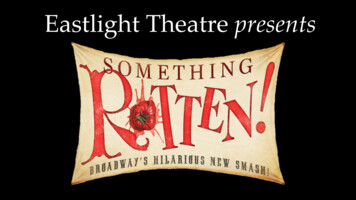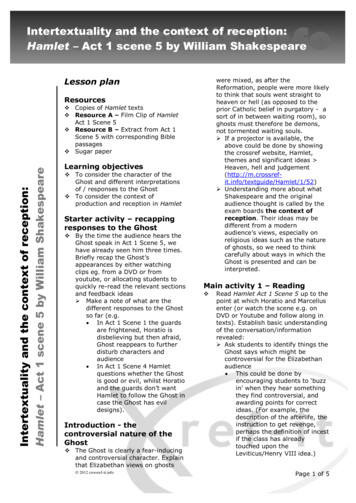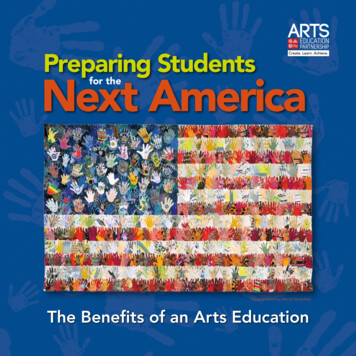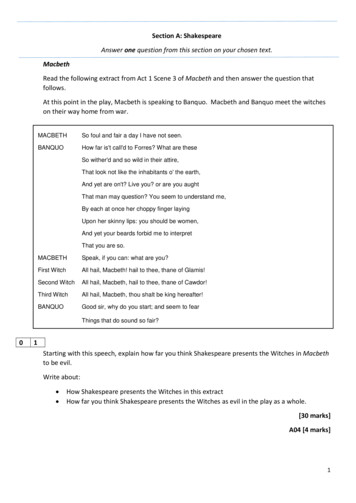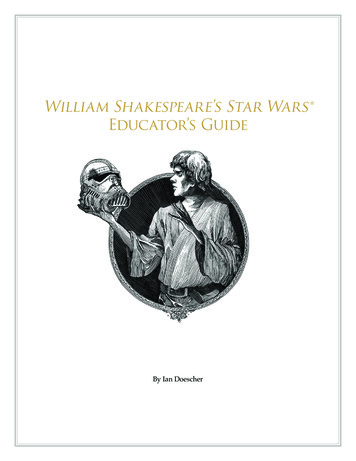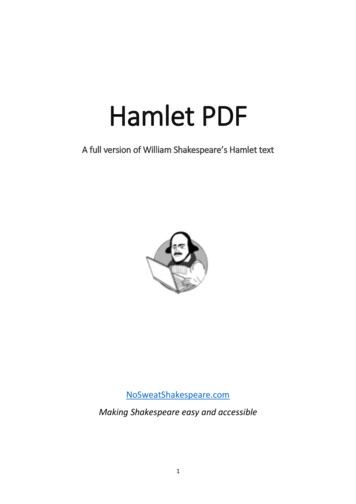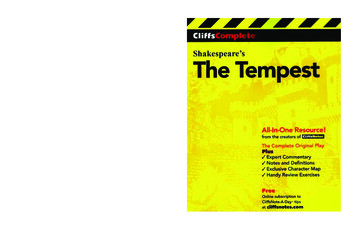
Transcription
CLIFFSCOMPLETEShakespeare’sTheTempestEdited by Sidney LambAssociate Professor of EnglishSir George Williams University, MontrealComplete Text Commentary GlossaryCommentary by Matthew HansenIDG Books Worldwide, Inc.An International Data Group CompanyFoster City, CA Chicago, IL Indianapolis, IN New York, NY
CLIFFSCOMPLETEShakespeare’sTheTempest
About the AuthorMatthew C. Hansen has a B.A. in English from Washington & Lee University and an M.Phil. with a concentration on Shakespeare and EarlyModern Drama from University College, Oxford. He has taught literatureand directed productions of Shakespeare in England and the United Statesincluding, most recently, a production of The Tempest. He is currently aPh.D. candidate at the University of Nebraska at Lincoln where he holdsa teaching fellowship.CliffsComplete The TempestPublished byIDG Books Worldwide, Inc.An International Data Group Company919 E. Hillsdale Blvd.Suite 400Foster City, CA 94404www.idgbooks.com (IDG Books Worldwide Web site)www.cliffsnotes.com (CliffsNotes Web site)Publisher’s AcknowledgmentsEditorialProject Editor: Elizabeth Netedu KuballAcquisitions Editor: Gregory W. TubachEditorial Director: Kristin A. CocksIllustrator: DD DowdenSpecial Help: Michelle HackerProductionIndexer: Glassman Indexing ServicesProofreader: Jeannie SmithIDG Books Indianapolis Production DepartmentNote: If you purchased this book without a cover youshould be aware that this book is stolen property. It wasreported as "unsold and destroyed" to the publisher, andneither the author nor the publisher has received anypayment for this "stripped book."Copyright 2000 IDG Books Worldwide, Inc. All rights reserved. No part of this book, including interior design, cover design, and icons, may be reproduced or transmitted in any form, byany means (electronic, photocopying, recording, or otherwise) without the prior written permission of the publisher.Library of Congress Control No.: 00-101105ISBN: 0-7645-8576-2Printed in the United States of America10 9 8 7 6 5 4 3 2 11O/QU/QV/QQ/INDistributed in the United States by IDG Books Worldwide, Inc.Distributed by CDG Books Canada Inc. for Canada; by Transworld Publishers Limited in the United Kingdom; by IDG Norge Books for Norway; by IDG Sweden Books for Sweden; byIDG Books Australia Publishing Corporation Pty. Ltd. for Australia and New Zealand; by TransQuest Publishers Pte Ltd. for Singapore, Malaysia, Thailand, Indonesia, and Hong Kong; byGotop Information Inc. for Taiwan; by ICG Muse, Inc. for Japan; by Intersoft for South Africa; by Eyrolles for France; by International Thomson Publishing for Germany, Austria andSwitzerland; by Distribuidora Cuspide for Argentina; by LR International for Brazil; by Galileo Libros for Chile; by Ediciones ZETA S.C.R. Ltda. for Peru; by WS Computer PublishingCorporation, Inc., for the Philippines; by Contemporanea de Ediciones for Venezuela; by Express Computer Distributors for the Caribbean and West Indies; by Micronesia Media Distributor, Inc. for Micronesia; by Chips Computadoras S.A. de C.V. for Mexico; by Editorial Norma de Panama S.A. for Panama; by American Bookshops for Finland.For general information on IDG Books Worldwide’s books in the U.S., please call our Consumer Customer Service department at 800-762-2974. For reseller information, including discounts and premium sales, please call our Reseller Customer Service department at 800-434-3422.For information on where to purchase IDG Books Worldwide’s books outside the U.S., please contact our International Sales department at 317-596-5530 or fax 317-572-4002.For consumer information on foreign language translations, please contact our Customer Service department at 1-800-434-3422, fax 317-572-4002, or e-mail rights@idgbooks.com.For information on licensing foreign or domestic rights, please phone 1-650-653-7098.For sales inquiries and special prices for bulk quantities, please contact our Order Services department at 800-434-3422 or write to the address above.For information on using IDG Books Worldwide’s books in the classroom or for ordering examination copies, please contact our Educational Sales department at 800-434-2086 or fax317-572-4005.For press review copies, author interviews, or other publicity information, please contact our Public Relations department at 650-653-7000 or fax 650-653-7500.For authorization to photocopy items for corporate, personal, or educational use, please contact Copyright Clearance Center, 222 Rosewood Drive, Danvers, MA 01923, or fax978-750-4470.LIMIT OF LIABILITY/DISCLAIMER OF WARRANTY: THE PUBLISHER AND AUTHOR HAVE USED THEIR BEST EFFORTS IN PREPARING THIS BOOK. THE PUBLISHER AND AUTHOR MAKE NO REPRESENTATIONS OR WARRANTIES WITH RESPECT TO THE ACCURACY OR COMPLETENESS OF THE CONTENTS OFTHIS BOOK AND SPECIFICALLY DISCLAIM ANY IMPLIED WARRANTIES OF MERCHANTABILITY OR FITNESS FOR A PARTICULAR PURPOSE. THERE ARE NOWARRANTIES WHICH EXTEND BEYOND THE DESCRIPTIONS CONTAINED IN THIS PARAGRAPH. NO WARRANTY MAY BE CREATED OR EXTENDED BY SALESREPRESENTATIVES OR WRITTEN SALES MATERIALS. THE ACCURACY AND COMPLETENESS OF THE INFORMATION PROVIDED HEREIN AND THE OPINIONSSTATED HEREIN ARE NOT GUARANTEED OR WARRANTED TO PRODUCE ANY PARTICULAR RESULTS, AND THE ADVICE AND STRATEGIES CONTAINEDHEREIN MAY NOT BE SUITABLE FOR EVERY INDIVIDUAL. NEITHER THE PUBLISHER NOR AUTHOR SHALL BE LIABLE FOR ANY LOSS OF PROFIT OR ANYOTHER COMMERCIAL DAMAGES, INCLUDING BUT NOT LIMITED TO SPECIAL, INCIDENTAL, CONSEQUENTIAL, OR OTHER DAMAGES. FULFILLMENT OFEACH COUPON OFFER IS THE RESPONSIBILITY OF THE OFFEROR.Trademarks: Cliffs, CliffsNotes, and all related logos and trade dress are registered trademarks or trademarks of CliffsNotes, Inc. in the United States and other countries. All other brandnames and product names used in this book are trade names, service marks, trademarks, or registered trademarks of their respective owners. IDG Books Worldwide, Inc. and CliffsNotes, Inc.are not associated with any product or vendor mentioned in this book.is a registered trademark under exclusive licenseto IDG Books Worldwide, Inc. from International Data Group, Inc.
CLIFFSCOMPLETEShakespeare’sThe TempestCONTENTS AT A GLANCEIntroduction . . . . . . . . . . . . . . . . . . . . . . . . . . . . . . . . . . 1ACT I . . . . . . . . . . . . . . . . . . . . . . . . . . . . . . . . . . . . . . . 31ACT II . . . . . . . . . . . . . . . . . . . . . . . . . . . . . . . . . . . . . . 63ACT III. . . . . . . . . . . . . . . . . . . . . . . . . . . . . . . . . . . . . . 89ACT IV. . . . . . . . . . . . . . . . . . . . . . . . . . . . . . . . . . . . . 111ACT V . . . . . . . . . . . . . . . . . . . . . . . . . . . . . . . . . . . . . 127CliffsComplete Review . . . . . . . . . . . . . . . . . . . . . . . 143CliffsComplete Resource Center . . . . . . . . . . . . . . . 150Index . . . . . . . . . . . . . . . . . . . . . . . . . . . . . . . . . . . . . . 157
CLIFFSCOMPLETEShakespeare’sThe TempestTABLE OF CONTENTSIntroduction: The Tempest . . . . . . . . . . . . . . . . . . . . . . 1Introduction to William Shakespeare . . . . . . . . . . . . . . . . . . . . . . . . . 1Introduction to Early Modern England . . . . . . . . . . . . . . . . . . . . . . . 7Introduction to The Tempest . . . . . . . . . . . . . . . . . . . . . . . . . . . . . . 17Character Map . . . . . . . . . . . . . . . . . . . . . . . . . . . . . . . . . . . . . . . . . 28ACT I,Scene 1Scene 2[A ship at sea.] . . . . . . . . . . . . . . . . . . . . . . . 31[Before Prospero’s cell.] . . . . . . . . . . . . . . . . . 35ACT II,Scene 1Scene 2[Another part of the island.] . . . . . . . . . . . . . 63[Another part of the island.] . . . . . . . . . . . . . 77ACT III,Scene 1Scene 2Scene 3[Before Prospero’s cell.] . . . . . . . . . . . . . . . . . 89[Another part of the island.] . . . . . . . . . . . . . 94[Another part of the island.] . . . . . . . . . . . . 101ACT IVScene 1[Before Prospero’s cell.] . . . . . . . . . . . . . . . . 111ACT VScene 1[Before Prospero’s cell.] . . . . . . . . . . . . . . . . 127CliffsComplete Review . . . . . . . . . . . . . . . . . . . . . . . 143CliffsComplete Resource Center . . . . . . . . . . . . . . . 150Index . . . . . . . . . . . . . . . . . . . . . . . . . . . . . . . . . . . . . . 157
viiiCliffsComplete The Tempest
Shakespeare’sTHE TEMPESTINTRODUCTION TOWILLIAM SHAKESPEAREWilliam Shakespeare, or the “Bard” as people fondlycall him, permeates almost all aspects of our society.He can be found in our classrooms, on our televisions, in our theatres, and in our cinemas. Speakingto us through his plays, Shakespeare comments onhis life and culture, as well as our own. Actors stillregularly perform his plays on the modern stage andscreen. The 1990s, for example, saw the release ofcinematic versions of Romeo and Juliet, Hamlet, Othello, A Midsummer Night’s Dream, and many more ofhis works.he does not tell us much about Shakespeare the person, forcing critics and scholars to look to historicalreferences to uncover the true-life great dramatist.Anti-Stratfordians — modern scholars whoquestion the authorship of Shakespeare’s plays —have used this lack of information to argue thatWilliam Shakespeare either never existed or, if he didexist, did not write any of the plays we attribute tohim. They believe that another historical figure, suchas Francis Bacon or Queen Elizabeth I, used thename as a cover. Whether or not a man namedIn addition to the popularity of Shakespeare’splays as he wrote them, other writers have modernized his works to attract new audiences. For example, West Side Story places Romeo and Juliet in NewYork City, and A Thousand Acres sets King Lear inIowa corn country. Beyond adaptations and productions, his life and works have captured our cultural imagination. The twentieth century witnessedthe production of a play about two minor charactersfrom Shakespeare’s Hamlet in Rosencrantz andGuildenstern Are Dead and a fictional movie aboutShakespeare’s early life and poetic inspiration inShakespeare in Love.Despite his monumental presence in our culture,Shakespeare remains enigmatic. He does not tell uswhich plays he wrote alone, on which plays he collaborated with other playwrights, or which versionsof his plays to read and perform. Furthermore, withonly a handful of documents available about his life,An engraved portrait of Shakespeare by an unknown artist, ca. 1607.Culver Pictures, Inc./SuperStock
2CliffsComplete The TempestWilliam Shakespeare ever actually existed is ultimately secondary to the recognition that the groupof plays bound together by that name does exist andcontinues to educate, enlighten, and entertain us.Family lifeThough scholars are unsure of the exact date ofShakespeare’s birth, records indicate that hisparents — Mary and John Shakespeare — baptizedhim on April 26, 1564, in the small provincial townof Stratford-upon-Avon — so named because it saton the banks of the Avon river. Because commonpractice was to baptize infants a few days after theywere born, scholars generally recognize April 23,1564, as Shakespeare’s birthday. Coincidentally, April23 is the day of St. George, the patron saint of England, as well as the day upon which Shakespearewould die 52 years later. William was the third ofMary and John’s eight children and the first of foursons. The house in which scholars believe Shakespeare to have been born stands on Henley Streetand, despite many modifications over the years, youcan still visit it today.Shakespeare’s fatherPrior to Shakespeare’s birth, John Shakespeare livedin Snitterfield, where he married Mary Arden, thedaughter of his landlord. After moving to Stratfordin 1552, he worked as a glover, a moneylender, anda dealer in agricultural products such as wool andgrain. He also pursued public office and achieved avariety of posts including bailiff, Stratford’s highestelected position — equivalent to a small town’smayor. At the height of his career, sometime near1576, he petitioned the Herald’s Office for a coat ofarms and thus the right to be a gentleman. But therise from the middle class to the gentry did not comeright away, and the costly petition expired withoutbeing granted.Shakespeare’s birthplace.SuperStockAbout this time, John Shakespeare mysteriouslyfell into financial difficulty. He became involved inserious litigation, was assessed heavy fines, and evenlost his seat on the town council. Some scholars suggest that this decline could have resulted from religious discrimination because the Shakespeare familymay have supported Catholicism, the practice ofwhich was illegal in England. However, other scholars point out that not all religious dissenters (bothCatholics and radical Puritans) lost their posts dueto their religion. Whatever the cause of his decline,John did regain some prosperity toward the end ofhis life. In 1596, the Herald’s Office granted theShakespeare family a coat of arms at the petition ofWilliam, by now a successful playwright in London.And John, prior to his death in 1601, regained hisseat on Stratford’s town council.Childhood and educationOur understanding of William Shakespeare’s childhood in Stratford is primarily speculative because children do not often appear in the legal records fromwhich many scholars attempt to reconstruct Shakespeare’s life. Based on his father’s local prominence,scholars speculate that Shakespeare most likelyattended King’s New School, a school that usuallyemployed Oxford graduates and was generally well
Introduction to William Shakespearerespected. Shakespeare would have started pettyschool — the rough equivalent to modern preschool — at the age of four or five. He would havelearned to read on a hornbook, which was a sheet ofparchment or paper on which the alphabet and theLord’s Prayer were written. This sheet was framed inwood and covered with a transparent piece of hornfor durability. After two years in petty school, hewould have transferred to grammar school, where hisschool day would have probably lasted from 6 or7 o’clock in the morning (depending on the time ofyear) until 5 o’clock in the evening, with only ahandful of holidays.While in grammar school, Shakespeare wouldprimarily have studied Latin, reciting and readingthe works of classical Roman authors such as Plautus, Ovid, Seneca, and Horace. Traces of theseauthors’ works can be seen in his dramatic texts.Toward his last years in grammar school, Shakespearewould have acquired some basic skills in Greek aswell. Thus the remark made by Ben Jonson, Shakespeare’s well-educated friend and contemporary playwright, that Shakespeare knew “small Latin and lessGreek” is accurate. Jonson is not saying that whenShakespeare left grammar school he was only semiliterate; he merely indicates that Shakespeare did notattend University, where he would have gained moreLatin and Greek instruction.Wife and childrenWhen Shakespeare became an adult, the historicalrecords documenting his existence began to increase.In November 1582, at the age of 18, he married 26year-old Anne Hathaway from the nearby village ofShottery. The disparity in their ages, coupled withthe fact that they baptized their first daughter,Susanna, only six months later in May 1583, hascaused a great deal of modern speculation about thenature of their relationship. However, sixteenth-century conceptions of marriage differed slightly fromour modern notions. Though all marriages neededto be performed before a member of the clergy,3many of Shakespeare’s contemporaries believed thata couple could establish a relationship through a premarital contract by exchanging vows in front of witnesses. This contract removed the social stigma ofpregnancy before marriage. (Shakespeare’s plays contain instances of marriage prompted by pregnancy,and Measure for Measure includes this kind of premarital contract.) Two years later, in February 1585,Shakespeare baptized his twins Hamnet and Judith.Hamnet died at the age of 11 when Shakespeare wasprimarily living away from his family in London.For seven years after the twins’ baptism, therecords remain silent on Shakespeare. At some point,he traveled to London and became involved with thetheatre, but he could have been anywhere between21 and 28 years old when he did. Though some havesuggested that he may have served as an assistant toa schoolmaster at a provincial school, it seems likelythat he went to London to become an actor, gradually becoming a playwright and gaining attention.The plays: On stage and in printThe next mention of Shakespeare comes in 1592 bya University wit named Robert Greene when Shakespeare apparently was already a rising actor andplaywright for the London stage. Greene, no longera successful playwright, tried to warn other University wits about Shakespeare. He wrote:For there is an upstart crow, beautified with ourfeathers, that with his “Tiger’s heart wrapped in aplayer’s hide” supposes he is as well able to bombastout a blank verse as the best of you, and, being anabsolute Johannes Factotum, is in his own conceit theonly Shake-scene in a country.This statement comes at a point in time whenmen without a university education, like Shakespeare, were starting to compete as dramatists withthe University wits. As many critics have pointed out,Greene’s statement recalls a line from 3 Henry VI,
4CliffsComplete The Tempestwhich reads, “O tiger’s heart wrapped in a woman’shide!” (I.4.137). Greene’s remark does not indicatethat Shakespeare was generally disliked. On the contrary, another University wit, Thomas Nashe, wroteof the great theatrical success of Henry VI, and HenryChettle, Greene’s publisher, later printed a flatteringapology to Shakespeare. What Greene’s statementdoes show us is that Shakespeare’s reputation forpoetry had reached enough of a prominence to provoke the envy of a failing competitor.A ground plan of London after the fire of 1666, drawn by Marcus Willemsz Doornik.Guildhall Library, London/AKG, Berlin/SuperStockIn the following year, 1593, the governmentclosed London’s theatres due to an outbreak of thebubonic plague. Publication history suggests thatduring this closure, Shakespeare may have writtenhis two narrative poems, Venus and Adonis, publishedin 1593, and The Rape of Lucrece, published in 1594.These are the only two works that Shakespeare seemsto have helped into print; each carries a dedicationby Shakespeare to Henry Wriothesley, Earl ofSouthampton.Stage successWhen the theatres reopened in 1594, Shakespearejoined the Lord Chamberlain’s Men, an acting company. Though uncertain about the history of his earlydramatic works, scholars believe that by this point hehad written The Two Gentlemen of Verona, The Taming of the Shrew, the Henry VI trilogy, and TitusAndronicus. During his early years in the theatre, heprimarily wrote history plays, with his romantic comedies emerging in the 1590s. Even at this early stage inhis career, Shakespeare was a success. In 1597, he wasable to purchase New Place,one of the two largest housesin Stratford, and secure acoat of arms for his family.In 1597, the lease expired on the Lord Chamberlain’s playhouse, called TheTheatre. Because the ownerof The Theatre refused torenew the lease, the actingcompany was forced to perform at various playhousesuntil the 1599 opening of thenow famous Globe Theatre,which was literally built withlumber from The Theatre.(The Globe, later destroyedby fire, has recently beenreconstructed in London and can be visited today.)Recent scholars suggest that Shakespeare’s greattragedy, Julius Caesar, may have been the first ofShakespeare’s plays performed in the original playhouse. When this open-air theatre on the ThamesRiver opened, financial papers list Shakespeare’sname as one of the principal investors. Already anactor and a playwright, Shakespeare was now becoming a “Company Man.” This new status allowed himto share in the profits of the theatre rather thanmerely getting paid for his plays, some of which publishers were beginning to release in quarto format.
Introduction to William ShakespearePublicationsA quarto was a small, inexpensive book typically usedfor leisure books such as plays; the term itself indicates that the printer folded the paper four times.The modern day equivalent of a quarto would be apaperback. In contrast, the first collected works ofShakespeare were in folio format, which means thatthe printer folded each sheet only once. Scholars callthe collected edition of Shakespeare’s works the FirstFolio. A folio was a larger and more prestigious bookthan a quarto, and printers generally reserved the format for works such as the Bible.No evidence exists that Shakespeare participatedin the publication of any of his plays. Members ofShakespeare’s acting company printed the First Folioseven years after Shakespeare’s death. Generally, playwrights wrote their works to be performed on stage,and publishing them was a novel innovation at thetime. Shakespeare probably would not have thoughtof them as books in the way we do. In fact, as a principal investor in the acting company (which purchased the play as well as the exclusive right toperform it), he may not have even thought of themas his own. He would probably have thought of hisplays as belonging to the company.For this reason, scholars have generally characterized most quartos printed before the Folio as “bad” byarguing that printers pirated the plays and publishedthem illegally. How would a printer have received apirated copy of a play? The theories range from someone stealing a copy to an actor (or actors) selling theplay by relating it from memory to a printer. Manytimes, major differences exist between a quarto versionof the play and a folio version, causing uncertaintyabout which is Shakespeare’s true creation. Hamlet, forexample, is almost twice as long in the Folio as inquarto versions. Recently, scholars have come to realize the value of the different versions. The NortonShakespeare, for example, includes all three versions ofKing Lear — the quarto, the folio, and the conflatedversion (the combination of the quarto and folio).5Prolific productionsThe first decade of the 1600s witnessed the publication of additional quartos as well as the productionof most of Shakespeare’s great tragedies, with JuliusCaesar appearing in 1599 and Hamlet in 1600–1601.After the death of Queen Elizabeth in 1603, theLord Chamberlain’s Men became the King’s Menunder James I, Elizabeth’s successor. Around the timeof this transition in the English monarchy, thefamous tragedy Othello (1603–1604) was most likelywritten and performed, followed closely by King Lear(1605–1606), Antony and Cleopatra (1606), andMacbeth (1606) in the next two years.Shakespeare’s name also appears as a majorinvestor in the 1609 acquisition of an indoortheatre known as the Blackfriars. This last periodof Shakespeare’s career, which includes plays thatconsidered the acting conditions both at the Blackfriars and the open-air Globe theatre, consists primarily of romances or tragicomedies such as TheWinter’s Tale and The Tempest. On June 29, 1613,during a performance of All is True, or Henry VIII,the thatching on top of The Globe caught fire andthe playhouse burned to the ground. After thisincident, the King’s Men moved solely into theindoor Blackfriars Theatre.Final daysDuring the last years of his career, Shakespeare collaborated on a couple of plays with contemporary dramatist John Fletcher, even possibly coming out ofretirement — which scholars believe began sometimein 1613 — to work on The Two Noble Kinsmen(1613–1614). Three years later, Shakespeare died onApril 23, 1616. Though the exact cause of deathremains unknown, a vicar from Stratford in the midseventeenth-century wrote in his diary that Shakespeare, perhaps celebrating the marriage of hisdaughter, Judith, contracted a fever during a night ofrevelry with fellow literary figures Ben Jonson andMichael Drayton. Regardless, Shakespeare may have
6CliffsComplete The Tempestfelt his death was imminent in March of that year,because he altered his will. Interestingly, his will mentions no book or theatrical manuscripts, perhaps indicating the lack of value that he put on printed versionsof his dramatic works and their status as companyproperty.Seven years after Shakespeare’s death, JohnHeminge and Henry Condell, fellow members of theKing’s Men, published his collected works. In theirpreface, they claim that they are publishing the trueversions of Shakespeare’s plays partially as a responseto the previous quarto printings of 18 of his plays,most of these with multiple printings. This folio contains 36 plays to which scholars generally add Pericles and The Two Noble Kinsmen. This volume ofShakespeare’s plays began the process of constructing Shakespeare not only as England’s national poetbut also as a monumental figure whose plays wouldcontinue to captivate imaginations at the end of themillennium with no signs of stopping. Ben Jonson’sprophetic line about Shakespeare in the FirstFolio — “He was not of an age, but for all time!” —certainly holds true.Chronology of Shakespeare’s 1594–159515951595–1596The Two Gentlemen of VeronaThe Taming of the Shrew2 Henry VI3 Henry VI1 Henry VITitus AndronicusRichard IIIVenus and AdonisThe Rape of LucreceThe Comedy of ErrorsLove’s Labour’s LostRichard IIRomeo and JulietA Midsummer Night’s DreamLove’s Labour’s Won(This manuscript was lost.)15961596–1597King JohnThe Merchant of Venice1 Henry IV1597–1598The Merry Wives of Windsor2 Henry IV1598Much Ado About Nothing1598–1599Henry V1599Julius Caesar1599–1600As You Like It1600–1601Hamlet1601Twelfth Night, or What You Will1602Troilus and Cressida1593–1603Sonnets1603Measure for Measure1603–1604A Lover’s ComplaintOthello1604–1605All’s Well That Ends Well1605Timon of Athens1605–1606King Lear1606MacbethAntony and Cleopatra1607Pericles1608Coriolanus1609The Winter’s Tale1610Cymbeline1611The Tempest1612–1613Cardenio (with John Fletcher;this manuscript was lost.)1613All is True, or Henry VIII1613–1614The Two Noble Kinsmen(with John Fletcher)This chronology is derived from Stanley Wells’and Gary Taylor’s William Shakespeare: A TextualCompanion, which is listed in the “Works consulted”section below.A note on Shakespeare’s languageReaders encountering Shakespeare for the first timeusually find Early Modern English difficult to understand. Yet, rather than serving as a barrier to Shakespeare, the richness of this language should form partof our appreciation of the Bard.
8576-2 intro.F4/19/009:09 AMPage 7Introduction to Early Modern EnglandOne of the first things readers usually noticeabout the language is the use of pronouns. Like theKing James Version of the Bible, Shakespeare’s pronouns are slightly different from our own and cancause confusion. Words like “thou” (you), “thee” and“ye” (objective cases of you), and “thy” and “thine”(your/yours) appear throughout Shakespeare’s plays.You may need a little time to get used to thesechanges. You can find the definitions for other wordsthat commonly cause confusion in the glossary column on the right side of each page in this edition.Iambic pentameterThough Shakespeare sometimes wrote in prose, hewrote most of his plays in poetry, specifically blankverse. Blank verse consists of lines in unrhymediambic pentameter. Iambic refers to the stress patternsof the line. An iamb is an element of sound that consists of two beats — the first unstressed (da) and thesecond stressed (DA). A good example of an iambicline is Hamlet’s famous line “To be or not to be,” inwhich you do not stress “To,” “or,” and “to,” but youdo stress “be,” “not,” and “be.” Pentameter refers tothe meter or number of stressed syllables in a line.Pentameter has five stressed syllables. Thus, Juliet’sline “But soft, what light through yonder windowbreaks?” (II.2.2) is a good example of an iambic pentameter line.WordplayShakespeare’s language is also verbally rich, as he,along with many dramatists of his period, had afondness for wordplay. This wordplay often takes theforms of double meanings, called puns, where a wordcan mean more than one thing in a given context.Shakespeare often employs these puns as a way ofillustrating the distance between what is on the surface — apparent meanings — and what meanings lieunderneath. Though recognizing these puns may bedifficult at first, the notes in the far right columnpoint many of them out to you.7If you are encountering Shakespeare’s plays forthe first time, the following reading tips may helpease you into the plays. Shakespeare’s lines weremeant to be spoken; therefore, reading them aloudor speaking them should help with comprehension.Also, though most of the lines are poetic, do not forget to read complete sentences — move from periodto period as well as from line to line. AlthoughShakespeare’s language can be difficult at first, therewards of immersing yourself in the richness andfluidity of the lines are immeasurable.Works consultedFor more information on Shakespeare’s life andworks, see the following:Bevington, David, ed. The Complete Works of Shakespeare. New York: Longman, 1997.Evans, G.Blakemore, ed. The Riverside Shakespeare.Boston: Houghton Mifflin Co., 1997.Greenblatt, Stephen, ed. The Norton Shakespeare.New York: W.W. Norton and Co., 1997.Kastan, David Scott, ed. A Companion to Shakespeare. Oxford: Blackwell, 1999.McDonald, Russ. The Bedford Companion to Shakespeare: An Introduction with Documents. Boston:Bedford-St. Martin’s Press, 1996.Wells, Stanley and Gary Taylor. William Shakespeare:A Textual Companion. New York: W.W. Nortonand Co., 1997.INTRODUCTION TO EARLYMODERN ENGLANDWilliam Shakespeare (1564–1616) lived during aperiod in England’s history that people have generally referred to as the English Renaissance. The termrenaissance, meaning rebirth, was applied to thisperiod of English history as a way of celebrating
8576-2 intro.F84/19/009:09 AMPage 8CliffsComplete The Tempestwhat
No part of this book, including interior design, cover design, and icons, may be reproduced or transmitted in any form, by any means (electronic, photocopying, recording, or otherwis
